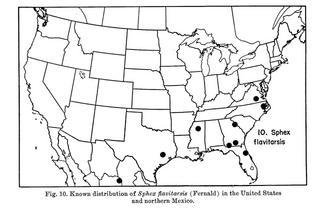
Bohart, R.M., Menke, A.S. 1963 · 0
Sphex flavitarsis, map |
|
|
Overview |
Taken from:
Bohart, R.M., Menke, A.S. 1963. A Reclassification of the Sphecinae: With a Revision of the Nearctic Species of the Tribes Sceliphronini and Sphecini.
Male.- Average length 23 mm; body black, wings evenly light brown; tegula, femoral apex, tibiae, tarsi orange red (fore femur extensively orange red); erect hair of head and thorax golden; face, lobe and apex of pronotum, tegula, scutal furrows, postscutellum, propodeum above hind coxa, episternal suture behind pronotal lobe, and fore coxa with appressed whitish to golden pubescence; flagellum about as in figure 91; sternite VIII with a short, broadly rounded, median projection; genitalia as in figures 72 and 79.
Female.- Average length 27 mm; essentially like male; fore femur with scattered bristly hair on lower one-half of outer surface.
|
|
|
Names | |
Sphex flavitarsis (Fernald)
(Figs. 10, 72, 79)
Sphex flavipes Smith, 1856, Cat. Hymen. Insects Brit. Mus., 4:263. Holotype ♀, “Georgia” (EMNU). Preoccupied by Sphex flavipes Fabricius, 1781.
Chlorion flavitarsis Fernald, 1906, Proc. United States Natl. Mus., 31:379. New name for flavipes Smith.
|
|
|
Geographic distribution | |
Distribution—We have seen specimens of flavitarsis from Florida, Georgia, North Carolina, Virginia, Mississippi, eastern Texas, and northern Durango, Mexico (fig. 10).
|
|
|
Natural history | |
Murray (1951) placed flavitarsis as a subspecies of opacus Dahlbom. The two are distinct on the basis of male genitalia, however, and opacus is South American.
|
|
| Supported by | |
Updated: 2024-04-24 09:36:24 gmt
|